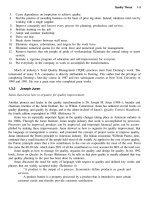Dimensioning and Tolerancing Handbook P2
Bạn đang xem bản rút gọn của tài liệu. Xem và tải ngay bản đầy đủ của tài liệu tại đây (72.59 KB, 20 trang )
Quality Thrust 1-3
3. Cease dependence on inspection to achieve quality.
4. End the practice of awarding business on the basis of price tag alone. Instead, minimize total cost by
working with a single supplier.
5. Improve constantly and forever every process for planning, production, and service.
6. Institute training on the job.
7. Adopt and institute leadership.
8. Drive out fear.
9. Break down barriers between staff areas.
10. Eliminate slogans, exhortations, and targets for the work force.
11. Eliminate numerical quotas for the work force and numerical goals for management.
12. Remove barriers that rob people of pride of workmanship. Eliminate the annual rating or merit
system.
13. Institute a vigorous program of education and self-improvement for everyone.
14. Put everybody in the company to work to accomplish the transformation.
Much of industry’s Total Quality Management (TQM) practices stem from Deming’s work. The
turnaround of many U.S. companies is directly attributable to Deming. This author had the privilege of
completing Deming’s four-day course in 1987 and two subsequent courses at New York University in
1990 and 1991. He was a great man who completed great works.
1.3.2 Joseph Juran
Juran showed us how to organize for quality improvement.
Another pioneer and leader in the quality transformation is Dr. Joseph M. Juran (1904–), founder and
chairman emeritus of the Juran Institute, Inc. in Wilton, Connecticut. Juran has authored several books on
quality planning, and quality by design, and is the editor-in-chief of Juran’s Quality Control Handbook,
the fourth edition copyrighted in 1988. (Reference 5)
Juran was an especially important figure in the quality changes taking place in American industry in
the 1980s. Through the Juran Institute, Juran taught industry that work is accomplished by processes.
Processes can be improved, products can be improved, and important financial gains can be accom-
plished by making these improvements. Juran showed us how to organize for quality improvement, that
the language of management is money, and promoted the concept of project teams to improve quality.
Juran introduced the Pareto principle to American industry. The Italian economist, Wilfredo Pareto, dem-
onstrated that a small fraction of the people held most of the wealth. As applied to the cost of poor quality,
the Pareto principle states that a few contributors to the cost are responsible for most of the cost. From
this came the 80-20 rule, which states 20% of all the contributors to cost, account for 80% of the total cost.
Juran taught us how to manage for quality, organize for quality, and design for quality. In his 1992
book, Juran on Quality by Design (Reference 4), he tells us that poor quality is usually planned that way
and quality planning in the past has been done by amateurs.
Juran discussed the need for unity of language with respect to quality and defined key words and
phrases that are widely accepted today: (Reference 4)
“A product is the output of a process. Economists define products as goods and
services.
A product feature is a property possessed by a product that is intended to meet certain
customer needs and thereby provide customer satisfaction.
1-4 Chapter One
Customer satisfaction is a result achieved when product features respond to customer
needs. It is generally synonymous with product satisfaction. Product satisfaction is a
stimulus to product salability. The major impact is on share of market, and thereby on
sales income.
A product deficiency is a product failure that results in product dissatisfaction. The
major impact is on the costs incurred to redo prior work, to respond to customer com-
plaints, and so on.
Product deficiencies are, in all cases, sources of customer dissatisfaction.
Product satisfaction and product dissatisfaction are not opposites. Satisfaction has its
origins in product features and is why clients buy the product. Dissatisfaction has its ori-
gin in non-conformances and is why customers complain. There are products that give no
dissatisfaction; they do what the supplier said they would do. Yet, the customer is dissat-
isfied with the product if there is some competing product providing greater satisfaction.
A customer is anyone who is impacted by the product or process. Customers may be
internal or external.”
This author has had the honor and privilege to work with Dr. Juran on company and national quality
efforts in the 1980s and 1990s. Dr. Juran showed us how to manage for quality. He is a great teacher,
leader, and mentor.
1.3.3 Philip B. Crosby
Doing things right the first time adds nothing to the cost of your product of service. Doing things wrong
is what costs money.
In his book, Quality is Free—The Art of Making Quality Certain (Reference 1) Crosby introduced
valuable quality-building tools that caught the attention of Western Management in the early 1980s.
Crosby developed many of these ideas and methods during his industrial career at International Tele-
phone and Telegraph Corporation. Crosby went on to teach these methods to managers at the Crosby
Quality College in Florida.
• Quality Management Maturity Grid—An entire objective system for measuring your present quality
system. Easy to use, it pinpoints areas in your operation for potential improvement.
• Quality Improvement Program—A proven 14-step procedure to turn your business around.
• Make Certain Program—The first defect prevention program ever for white-collar and nonmanufacturing
employees.
• Management Style Evaluation—A self-examination process for managers that shows how personal
qualities may be influencing product quality.
Crosby demonstrated that the typical American corporation spends 15% to 20% of its sales dollars on
inspection, tests, warranties, and other quality-related costs. Crosby’s work went on to define the ele-
ments of the cost of poor quality that are in use today at many corporations. Prevention costs, appraisal
costs, and failure costs are well defined, and a system for periodic accounting is demonstrated.
In this author’s experience with many large corporations, there is a direct correlation between the
number of defects produced and the cost of poor quality. Crosby was the leader who showed how to
qualitatively correlate defects with money, which Juran showed us, is the language of management.
Quality Thrust 1-5
1.3.4 Genichi Taguchi
Monetary losses occur with any deviation from the nominal.
Dr. Genichi Taguchi is the Japanese engineer that understood and quantified the effects of variation on
the final product quality. (Reference 11) He understood and quantified the fact that any deviation from the
nominal will cause a quantifiable cost, or loss. Most of Western management thinking today still believes
that loss occurs only when a specification has been violated, which usually results in scrap or rework. The
truth is that any design works best when all elements are at their target value.
Taguchi quantified the cost of variation and set forth this important mathematical relationship. Taguchi
quantified what Juran, Crosby and others continue to teach. The language of management is money, and
deviations from standard are losses. These losses are in performance, customer satisfaction, and supplier
and manufacturing efficiency. These losses are real and can be quantified in terms of money.
Taguchi’s Loss Function (Fig. 1-1) is defined as follows:
Monetary loss is a function of each product feature (x), and its difference from the best (target) value.
T
x
Loss (L)
a
b
x is a measure of a product characteristic
T is the target value of x
a = amount of loss when x is not on target T
b = amount that x is away from the target T
In this illustration, T = x , where
x
is the mean of the sample of x’ss
In the simple case for one value of x, the loss is:
L = k(x – T)
2
, where k = a/b
2
This simple quadratic equation is a good model for estimating the cost of not being on target.
The more general case can be expressed using knowledge of how the product characteristic (x) varies.
The following model assumes a normal distribution, which is symmetrical about the average x .
L(x) = k[( x – T)
2
+ s
2
], where s = the standard deviation of the sample of x’ss
The principles of Taguchi’s Loss Function are fundamental to modern manufacturability and sys-
tems engineering analyses. Each function and each feature of a product can be analyzed individually. The
summation of the estimated losses can lead an integrated design and manufacturing team to make tradeoffs
quantitatively and early in the design process. (Reference 12)
Figure 1-1 Taguchi’s loss function and a
normal distribution
1-6 Chapter One
1.4 The Six Sigma Approach to Quality
An aggressive campaign to boost profitability, increase market share, and improve customer satisfaction
that has been launched by a select group of leaders in American Industry. (Reference 3)
1.4.1 The History of Six Sigma (Reference 10)
“In 1981, Bob Galvin, then chairman of Motorola, challenged his company to achieve
a tenfold improvement in performance over a five-year period. While Motorola execu-
tives were looking for ways to cut waste, an engineer by the name of Bill Smith was study-
ing the correlation between a product’s field life and how often that product had been
repaired during the manufacturing process. In 1985, Smith presented a paper concluding
that if a product were found defective and corrected during the production process, other
defects were bound to be missed and found later by the customer during the early use by
the consumer. Additionally, Motorola was finding that best-in-class manufacturers were
making products that required no repair or rework during the manufacturing process. (These
were Six Sigma products.)
In 1988, Motorola won the Malcolm Baldrige National Quality Award, which set the
standard for other companies to emulate.
(This author had the opportunity to examine some of Motorola’s processes and prod-
ucts that were very near Six Sigma. These were nearly 2,000 times better than any prod-
ucts or processes that we at Texas Instruments (TI) Defense Systems and Electronics
Group (DSEG) had ever seen. This benchmark caused DSEG to re-examine its product
design and product production processes. Six Sigma was a very important element in
Motorola’s award winning application. TI’s DSEG continued to make formal applications to
the MBNQA office and won the award in 1992. Six Sigma was a very important part of the
winning application.)
As other companies studied its success, Motorola realized its strategy to attain Six
Sigma could be further extended.” (Reference 3)
Galvin requested that Mikel J. Harry, then employed at Motorola’s Government Electronics Group in
Phoenix, Arizona, start the Six Sigma Research Institute (SSRI), circa 1990, at Motorola’s Schaumburg,
Illinois campus. With the financial support and participation of IBM, TI’s DSEG, Digital Equipment Corpo-
ration (DEC), Asea Brown Boveri Ltd. (ABB), and Kodak, the SSRI began developing deployment strate-
gies, and advanced applications of statistical methods for use by engineers and scientists.
Six Sigma Academy President, Richard Schroeder, and Harry joined forces at ABB to deploy Six Sigma
and refined the breakthrough strategy by focusing on the relationship between net profits and product
quality, productivity, and costs. The strategy resulted in a 68% reduction in defect levels and a 30%
reduction in product costs, leading to $898 million in savings/cost reductions each year for two years.
(Reference 13)
Schroeder and Harry established the Six Sigma Academy in 1994. Its client list includes companies
such as Allied Signal, General Electric, Sony, Texas Instruments DSEG (now part of Raytheon), Bombar-
dier, Crane Co., Lockheed Martin, and Polaroid. These companies correlate quality to the bottom line.
1.4.2 Six Sigma Success Stories
There are thousands of black belts working at companies worldwide. A blackbelt is an expert that can
apply and deploy the Six Sigma Methods. (Reference 13)
Quality Thrust 1-7
Jennifer Pokrzywinski, an analyst with Morgan Stanley, Dean Witter, Discover & Co.,
writes “Six Sigma companies typically achieve faster working capital turns; lower capital
spending as capacity is freed up; more productive R&D spending; faster new product
development; and greater customer satisfaction.” Pokrzywinski estimates that by the year
2000, GE’s gross annual benefit from Six Sigma could be $6.6 billion, or 5.5% of sales.
(Reference 7)
General Electric alone has trained about 6,000 people in the Six Sigma methods. The other compa-
nies mentioned above have trained thousands more. Each black belt typically completes three or four
projects per year that save about $150,000 each. The savings are huge, and customers and shareholders
are happier.
1.4.3 Six Sigma Basics
“The philosophy of Six Sigma recognizes that there is a direct correlation between the number of prod-
uct defects, wasted operating costs, and the level of customer satisfaction. The Six Sigma statistic mea-
sures the capability of the process to perform defect-free work….
With Six Sigma, the common measurement index is defects per unit and can include anything from a
component, piece of material, or line of code, to an administrative form, time frame, or distance. The sigma
value indicates how often defects are likely to occur. The higher the sigma value, the less likely a process
will produce defects.
Consequently, as sigma increases, product reliability improves, the need for testing and inspection
diminishes, work in progress declines, costs go down, cycle time goes down, and customer satisfaction
goes up.
Fig. 1-2 displays the short-term understanding of Six Sigma for a single critical-to-quality (CTQ)
characteristic; in other words, when the process is centered. Fig. 1-3 illustrates the long-term perspective
after the influence of process factors, which tend to affect process centering. From these figures, one can
readily see that the short-term definition will produce 0.002 parts per million (ppm) defective. However,
the long-term perspective reveals a defect rate of 3.4 ppm.
−6σ −5σ −4σ −3σ −2σ −1σ 0 1σ 2σ 3σ 4σ 5σ 6σ
Design Width
Process Width
Lower
Specification
Limit (LSL)
USL = 0.001 ppm
LSL = 0.001 ppm
Upper
Specification
Limit (USL)
Figure 1-2 Graphical definition of short-
term Six Sigma performance for a single
characteristic
1-8 Chapter One
(This degradation in the short-term performance of the process is largely due to the adverse effect of
long-term influences such as tool wear, material changes, and machine setup, just to mention a few. It is
these types of factors that tend to upset process centering over many cycles of manufacturing. In fact,
research has shown that a typical process is likely to deviate from its natural centered condition by
approximately ±1.5 standard deviations at any given moment in time. With this principle in hand, one can
make a rational estimate of the long-term process capability with knowledge of only the short-term perfor-
mance. For example, if the capability of a CTQ characteristic is ±6.0 sigma in the short term, the long-term
capability may be approximated as 6.0 sigma – 1.5 sigma = 4.5 sigma, or 3.4 ppm in terms of a defect rate.)”
(Reference 3)
Sigma Parts per Million Cost of Poor Quality
6 Sigma 3.4 defects per million < 10% of sales World class
5 Sigma 233 defects per million 10-15% of sales
4 Sigma 6210 defects per million 15-20% of sales Industry average
3 Sigma 66,807 defects per million 20-30% of sales
2 Sigma 308,537 defects per million 30-40% of sales Noncompetitive
1 Sigma 690,000 defects per million
Figure 1-3 Graphical definition of long-
term Six Sigma performance for a single
characteristic (distribution shifted 1.5σ)
For designers of products, it is vitally important to know the capability of the process that will be used
to manufacture a particular product feature. With this knowledge for each CTQ characteristic, an estimate
of the number of defects that are likely to happen during manufacturing can be made. Extending this idea
to the product level, a sigma value for the product design can be estimated. Products that are truly world-
class have values around 6.0 sigma before manufacturing begins. Products that are extremely complex, like
a large passenger jetliner, require sigma values greater than 6.0. Project managers and designers should
know the sigma value of their design before production begins. The sigma value is a measure of the
inherent manufacturability of the product.
Table 1-1 presents various levels of capability (manufacturability) and the implications to quality and
costs.
Table 1-1 Practical impact of process capability
−6σ −5σ −4σ −3σ −2σ −1σ 0 1σ 2σ 3σ 4σ 5σ 6σ
Design Width
±
6σ
Process Width
±
3σ
LSL
USL= 3.4 ppm
1.5σ
USL
Quality Thrust 1-9
1.5 The Malcolm Baldrige National Quality Award (MBNQA)
Describe how new products are designed.
The criteria for the MBNQA asks companies to describe how new products are designed, and to describe
how production processes are designed, implemented, and improved. Regarding design processes, the
criteria further asks “how design and production processes are coordinated to ensure trouble-free
introduction and delivery of products.”
The winners of the MBNQA and other world-class companies have very specific processes for
product design and product production. Most have an integrated product and process design process
that requires early estimates of manufacturability. Following the Six Sigma methodology will enable design
teams to estimate the quantitative measure of manufacturability.
What is the Malcolm Baldrige National Quality Award?
Congress established the award program in 1987 to recognize U.S. companies for their achievements in
quality and business performance and to raise awareness about the importance of quality and perfor-
mance excellence as a competitive edge. The award is not given for specific products or services. Two
awards may be given annually in each of three categories: manufacturing, service, and small business.
While the Baldrige Award and the Baldrige winners are the very visible centerpiece of the U.S.
quality movement, a broader national quality program has evolved around the award and its criteria. A
report, Building on Baldrige: American Quality for the 21st Century, by the private Council on Competi-
tiveness, states, “More than any other program, the Baldrige Quality Award is responsible for making
quality a national priority and disseminating best practices across the United States.”
The U.S. Commerce Department’s National Institute of Standards and Technology (NIST) manages
the award in close cooperation with the private sector.
Why was the award established?
In the early and mid-1980s, many industry and government leaders saw that a renewed emphasis on
quality was no longer an option for American companies but a necessity for doing business in an ever
expanding, and more demanding, competitive world market. But many American businesses either did
not believe quality mattered for them or did not know where to begin. The Baldrige Award was envi-
sioned as a standard of excellence that would help U.S. companies achieve world-class quality.
How is the Baldrige Award achieving its goals?
The criteria for the Baldrige Award have played a major role in achieving the goals established by
Congress. They now are accepted widely, not only in the United States but also around the world, as the
standard for performance excellence. The criteria are designed to help companies enhance their competi-
tiveness by focusing on two goals: delivering ever improving value to customers and improving overall
company performance.
The award program has proven to be a remarkably successful government and industry team effort.
The annual government investment of about $3 million is leveraged by more than $100 million of pri-
vate-sector contributions. This includes more than $10 million raised by private industry to help launch
the program, plus the time and efforts of hundreds of largely private-sector volunteers.
The cooperative nature of this joint government/private-sector team is perhaps best captured by the
award’s Board of Examiners. Each year, more than 300 experts from industry, as well as universities,
1-10 Chapter One
governments at all levels, and non-profit organizations, volunteer many hours reviewing applications for
the award, conducting site visits, and providing each applicant with an extensive feedback report citing
strengths and opportunities to improve. In addition, board members have given thousands of presenta-
tions on quality management, performance improvement, and the Baldrige Award.
The award-winning companies also have taken seriously their charge to be quality advocates. Their
efforts to educate and inform other companies and organizations on the benefits of using the Baldrige
Award framework and criteria have far exceeded expectations. To date, the winners have given approxi-
mately 30,000 presentations reaching thousands of organizations.
How does the Baldrige Award differ from ISO 9000?
The purpose, content, and focus of the Baldrige Award and ISO 9000 are very different. Congress created the
Baldrige Award in 1987 to enhance U.S. competitiveness. The award program promotes quality awareness,
recognizes quality achievements of U.S. companies, and provides a vehicle for sharing successful strategies.
The Baldrige Award criteria focus on results and continuous improvement. They provide a framework for
designing, implementing, and assessing a process for managing all business operations.
ISO 9000 is a series of five international standards published in 1987 by the International Organization
for Standardization (ISO), Geneva, Switzerland. Companies can use the standards to help determine what
is needed to maintain an efficient quality conformance system. For example, the standards describe the
need for an effective quality system, for ensuring that measuring and testing equipment is calibrated
regularly, and for maintaining an adequate record-keeping system. ISO 9000 registration determines
whether a company complies with its own quality system.
Overall, ISO 9000 registration covers less than 10 percent of the Baldrige Award criteria. (Reference 9)
1.6 References
1. Crosby, Philip B.1979. Quality is Free—The Art of Making Quality Certain. New York, NY: McGraw-Hill.
2. Deming, W. Edwards. 1982, 1986. Out of the Crisis. Cambridge, MA: Massachusetts Institute of Technology
Center for Advanced Engineering Study.
3. Harry, Mikel J. 1998. Six Sigma: A Breakthrough Strategy for Profitability. Quality Progress, May, 60–64.
4. Juran, J.M.1992. Juran on Quality by Design. New York: The Free Press.
5. Juran, J.M. 1988. Quality Control Handbook. 4th ed. New York, NY: McGraw-Hill.
6. Mann, Nancy R.1985,1987. The Keys to Excellence. Los Angeles: Prestwick Books.
7. Morgan Stanley, Dean Witter, Discover & Co. June 6, 1996. Company Update.
8. National Institute of Standards and Technology. 1998. U.S. Department of Commerce.
9. National Institute of Standards and Technology. U.S. Department of Commerce. 1998. Excerpt from “Fre-
quently Asked Questions and Answers about the Malcolm Baldrige National Quality Award.” Malcolm Baldrige
National Quality Award Office, A537 Administration Building, NIST, Gaithersburg, Maryland 20899-0001.
10. Six Sigma is a federally registered trademark of Motorola.
11. Taguchi, Genichi. 1970. Quality Assurance and Design of Inspection During Production. Reports of Statistical
Applications and Research 17(1). Japanese Union of Scientists and Engineers.
12. Taguchi, Genichi. 1985. System of Experimental Design. Vols. 1 and 2. White Plains, NY: Kraus International
Publications.
13. The terms Breakthrough Strategy, Champion, Master Black Belt, Black Belt, and Green Belt are federally
registered trademarks of Sigma Consultants, L.L.C., doing business as Six Sigma Academy.









